BLOOM KA-POW!

CARMELO BLANDINO JANUARY 17 - MARCH 2, 2023 Wasmer Art Gallery
Introduction
Carmelo Blandino’s seductive use of color and bold brushstrokes stand alone, as well as forming the intricate floral landscapes that serve as metaphors for a wide range of ideas. This layering of ideas embedded in the paintings remains vibrant and open to interpretation on many levels. I was not fully appreciative of this until I spent time with Blandino and his work in his studio. The process of curating this exhibition alongside Chad Jensen, Director of Method & Concept was a pleasure and a reminder of how much a work of art has to give if we spend time with it, especially in the context of years of work.
I hope this exhibition provides a glimpse into that larger context for those new to Blandino’s work and even for those who are committed collectors. Most of these paintings have not been on display side-byside before and it is exciting to see how they inform each other. The range of expressive capabilities is evident in Blandino’s ambition to push the subject to be playful, wonderous and at times even somber. The use of the flower becomes even more meaningful as we reflect on the many ways flowers are used to celebrate occasions in our lives from simple day-to-day events, the changing of the seasons and marking significant points in our lives. The interview in this catalogue reveals that while the paintings can be appreciated as being beautiful, they are also layered with a deep joy of life and awe of the unknown.
This exhibition would not have been possible without the dedicated supporters of the FGCU Art Galleries and the passionate collectors willing to loan the works for the exhibition. Chad Jensen and Carmelo Blandino spent countless hours to make this possible and I am honored that the Wasmer Art Gallery is the venue for this survey of Blandino’s work. I look forward to seeing Blandino’s work in the future as each piece creates unique moments for us to share together.
John Loscuito gallery director
 Carmelo Blandino seated before his painting, Baraka, 2020, Acrylic and spray paint on canvas, 96 x 72 in. On loan from the private collection of Louise Penta.
Carmelo Blandino seated before his painting, Baraka, 2020, Acrylic and spray paint on canvas, 96 x 72 in. On loan from the private collection of Louise Penta.
Why flowers?
There are so few things in life that embody such a universal truth and language, but at the same time can remain singular and defiant. For Blandino, this is his metaphor for life and work, symbolizing our human existence.
I first met Carmelo in 2008, at the time he was painting encaustic florals in a small studio in the Pine Ridge estates. The work felt classical in its approach and presentation, using time honored techniques like chiaroscuro, reminiscent of Old Masters like Caravaggio and da Vinci; even the medium itself, encaustic, hearkens back to a different time and place.
From those very early meetings with Carmelo, his energy was aligned in this way… contemporary, yet steeped in something deeper, and richer than his years, or our current millennium. Carmelo reminds us that beauty does have a place in contemporary art. While many contemporary artists of our time look to shock or provoke for a quick attention grab, or wrestle with complex narratives and heady concepts, Blandino takes a quieter, softer approach, drawing endless inspiration from nature and our outside world; where he finds infinite potential in its hidden compositions that escape the average view. For Blandino, nature is an inexhaustible resource.
Blandino only paints flowers from a period of growth until their fullest glory, and nothing after. He is not interested in death, decay, or destruction, as we all know this is the inevitable truth for all living things… for today, this exhibition, and for all works created by the hands of this modern master, we need only celebrate LIFE!
In co-curating Bloom Ka-Pow with gallery director, John Loscuito, our focus was to draw upon works from the latter part of Blandino’s Florida period, dating from 2016 to present day, which in my opinion, represents the most profound and developed artwork of his career; pulling from his experiences in print making, illustration, graffiti, and digital technologies.
I’m proud to count Carmelo Blandino as a dear friend, brother, and contemporary. It has been deeply rewarding to play a small role in his creative journey and to watch the phases of his life unfold on canvas before our eyes… there is much to be learned from his persistence through life and art, which for Carmelo, are one in the same.
CHAD JENSEN DIRECTOR, METHOD & CONCEPT • CO -CURATOR
 Carmelo Blandino, Ethos, 2019, Acrylic on canvas, 96 x 96 in. Collection of FGCU Art Galleries, Gift of Martin and Melanie Wasmer.
Carmelo Blandino, Ethos, 2019, Acrylic on canvas, 96 x 96 in. Collection of FGCU Art Galleries, Gift of Martin and Melanie Wasmer.
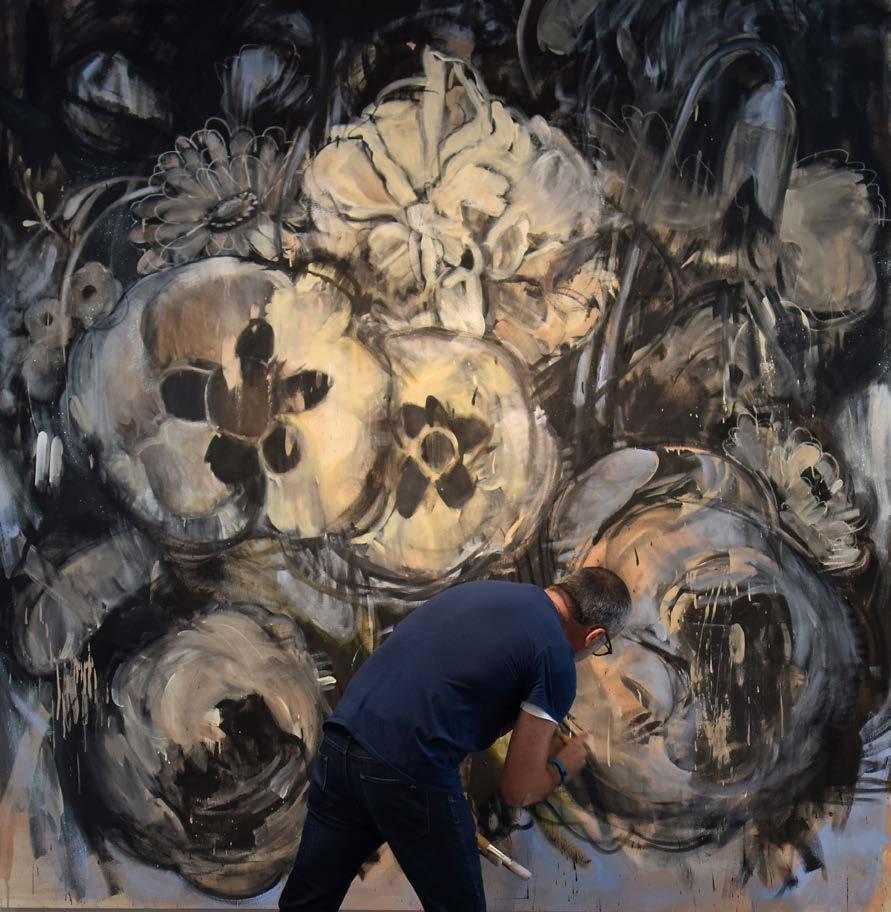 Carmelo Blandino in studio working on Ethos, 2019, Acrylic on canvas, 96 x 96 in. Collection of FGCU Art Galleries, Gift of Martin and Melanie Wasmer.
Carmelo Blandino in studio working on Ethos, 2019, Acrylic on canvas, 96 x 96 in. Collection of FGCU Art Galleries, Gift of Martin and Melanie Wasmer.
IN THE STUDIO WITH CARMElo BLANDINO
John Loscuito (JL): Thank you for inviting me to your studio to have this conversation. I have gotten to know your work over time, but this is a chance to dig a little bit deeper into the meaning embedded in your work. One of the things I am really interested in is why nature is important to you and why you keep coming back to it throughout your studio practice?
Carmelo Blandino (CB): It’s a thought-provoking question. I’ve always been sensitive to the obvious fact that we’re continuously surrounded by nature. We are nature, our bodies are made of nature, we walk through nature, we observe nature, we rest in it, we find solace, and it nurtures us. The thought of painting something outside of nature, that feels very artificial to me. Our entire biology, our DNA, and the stuff at the microscopic level that we don’t see is a direct reflection of everything that happens in nature. We have a symbiotic relationship with nature, we’re not detached, so where we start to think that we are, it is because we’re so involved in this go-go-go kind of life, needing to get this, needing to get that. We create a sort of like barrier, and we tend to forget that our car is not nature, walking through a field is what nature is. My work is about that, it’s like I’m highly sensitive to it. I enjoy it, I see the beauty in it, and I see the destructive power in it. It really is basically a reflection of human beings. We can be beautiful, we can be destructive, we could be neutral or colorful. You know, we could find peace within ourselves too, and nature does open that pathway toward peace.
JL: I really like that you related the internal structures of our bodies being a reflection of larger observations in nature. What is the relationship between the structure of a flower, which I know you come back to over and over again in your work, with our own bodies?
CB: They’re just forms; the integral part of the essence of both forms is what’s on the inside. It is the cosmic, and what surrounds it is what I would call the ethereal. What surrounds the actual form disappears, it doesn’t last forever. But what’s on the inside, once you remove the form, is not separate. I think the same thing that forms our body is the same thing that forms the flower. The difference is obviously the composition and the makeup of the other molecules that hold our body together versus the structure that holds the flower together. But the consciousness exists in both of them; it’s just that the form takes on a different appearance. That ethereal part of the form which is fleeting, disappears. Just like the flower; there’s a certain timespan at which we’re born, and then we bloom, and we’re a full force, and then slowly we start to head to the other side of the scale, and we return to the omniscient presence, or the cosmos, if you want to call it that. That’s really how I view nature. Because you can
feel that essence, you get out of your mind for a while and just really get into your body feeling the emotions and the essence of what you are. You can resonate with that, you know? You can feel that resonance like it’s speaking to you. That’s how I paint. It is the primarily pathway that I use to get into my paintings.
JL: Was it always that way for you when you first started painting flowers as a subject matter or have these relationships evolved over time for you?
CB: Yes, it’s evolved over time. I had an inclination at a very young age that there was something more to us than the appearance of what we look like. I ran with that. Then there were a lot of experiences that were unexplainable. The unexplainable got me hooked. I wondered why we live in the context of this high intellect and association with matter? I wanted to find out why we exist with the mystical and why we exist with the unexplainable. I realized that the unexplainable that I was looking for was actually inside of me already. So that sort of connection started to establish itself and I had glimpses of that as a child. But as I kept getting older and I kept my finger on it, I realized that the unexplainable was something primordial in all of us.
When you speak to somebody, you’re able to look into your unexplainable and their unexplainable and your mysticism and their mysticism. You’re now connecting on a whole different level. I started to look at the flowers and say, well, what if I were to paint the flowers at that level?
JL: I’ve noticed that along with the structure of the flower your work also includes expressionistic mark making. At times the flower form transforms or disintegrates. Does that come from entering into that mystical mindset you refer to?
CB: Yes, exactly, because in order to enter the mystical mindset, you have to do away with the layers and systems of belief that you have, that keep your structure intact. The structure is still there but the ideas of what I actually am or what you actually are, they begin to dissolve. This is a lot like how Maharishi talks about when you go into meditation and your form starts to disintegrate, and then suddenly you’re confronted with the question, who are you? And what am I? In order to delve into that, you have to basically remove your layers of identity, which are your system of beliefs that keep you structured within the form. You then enter the abstract, it’s inevitable. And so your expression becomes more abstract. You recognize that no matter what would happen to you, you never die, you’re eternal. What disintegrates is the form.
 Carmelo Blandino, Garden of Delights, 2019, Acrylic and charcoal on canvas, 60 x 144 in. On loan from the private collection of anonymous lender.
Carmelo Blandino, Garden of Delights, 2019, Acrylic and charcoal on canvas, 60 x 144 in. On loan from the private collection of anonymous lender.
So now you’re like, well, wait a second. I have this entire universe now that I can play with, which is infinite. I will never reach the end because there’s no boundary. Let’s go in there and play. So hence, now you’re playing with abstraction. Too much abstraction, however, doesn’t speak the narrative that I want, so I find a healthy balance. As I’m getting older and I’m starting to realize in my own endeavors, in my life and the things that I’ve been going through, just how much of this belief system related to my form do I need? So my whole primary purpose is to discard as much of it as possible while still staying within the realm of being able to live and cope, and so on. And then in my studio I get to play with abstraction. I explore elements that I think if I were a writer, I would probably write in volumes on mysticism and spirituality. But I’m an artist, so I prefer painting with the same ideas.
JL: When I first saw your work, there was this natural inclination to connect it to the history of still life painting and memento mori [Latin for ‘remember you must die’], using flowers as a symbol or metaphor for the different stages of our lives. But you’re talking about the process of using abstraction as a portal or a gateway into another state of being. Do you find that your viewers are responding to that?
CB: Yes, I think more and more, that becomes the topic of the conversation. And that’s exactly what a lot of viewers will come and say, your flowers are beautiful but, my God, I feel this sort of, like, opening in my heart or in my body, or I feel inspiration. Those are the words that obviously go beyond form. You’re in the realm of mysticism when you start talking about emotions like that. So definitely that sort of dialogue ensues. I’d like to take it further in my work. I’d like to pursue that even further. When you look at memento mori, and you look at 13th, 14th, 17th century artists, everybody goes through it, it doesn’t matter what age you live, but they had certain restrictions, such as society and the church and the state. But when you look at those paintings, there are definitely hints of it. And fortunately, in this time that I’m in right now, a lot of artists that were there before me have broken that mold. They’ve opened the pathway for me to be able to express myself and hopefully I’m doing the same thing for other artists.
JL: I know the process of painting took you pretty far on that journey of discovery. As you’re making work year after year and exploring different ideas and connecting it to your meditation practice, were there other life changing events that also opened that door for you?
CB: Yes, there’s been quite a few. I mean, relationships to people, definitely over the years, my relationship to myself. Looking at how the world changes and recognizing that nothing ever stays the same. Change is the only constant that we have, it’s constant. If you’re going to bet your money on something, that’s always change and then that’s kind of like a weird thing to say, but when you’re 17,
 Carmelo Blandino, No Thing Bouquet, 2019, Acrylic and pastel on canvas, 60 x 60 in. On loan from the private collection of Rick and Katrina Kash.
Carmelo Blandino, No Thing Bouquet, 2019, Acrylic and pastel on canvas, 60 x 60 in. On loan from the private collection of Rick and Katrina Kash.
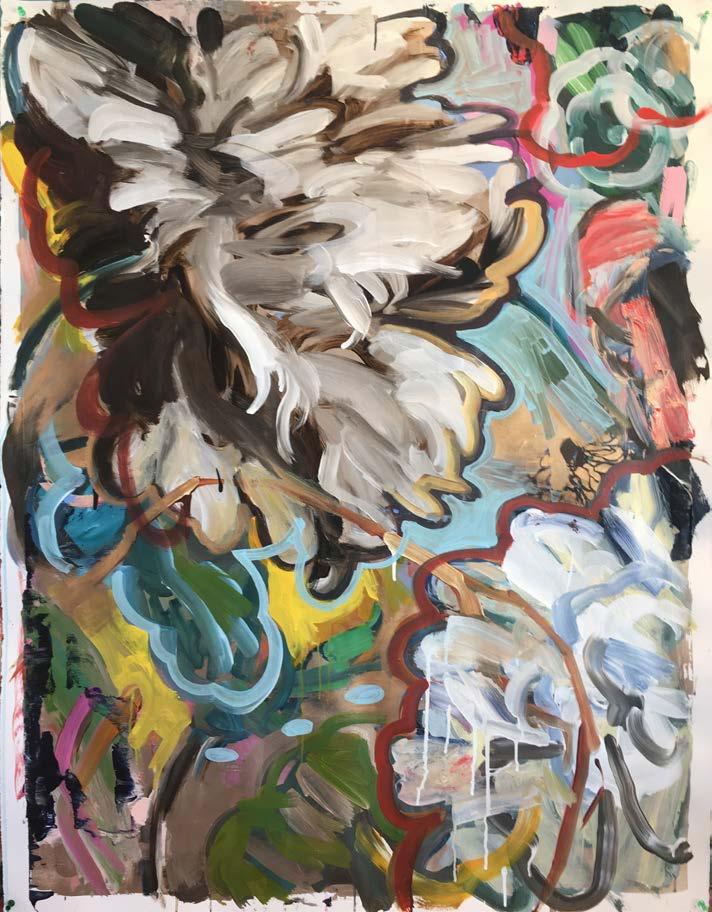 Carmelo Blandino, Study for a Painting VII, 2018, Acrylic on paper, 52 x 40 in. On loan from the private collection of Charlotte Corddry.
Carmelo Blandino, Study for a Painting VII, 2018, Acrylic on paper, 52 x 40 in. On loan from the private collection of Charlotte Corddry.
18, you think, well, this is it. From here on, I have control over everything and then [clap] no longer, right? You know, having been diagnosed with cancer, and also living with cancer, that brings in that layer where you ask, how are you going to live your life? Do you want to live it at a superficial level and pretend nothing is going on? Do you want to go deeper? Do you want to leave people inspired? These are the questions that come up and there’s nothing wrong with choosing either one. I think that for me, from day one, when I was young, I just naturally gravitated towards exploring mysticism. Thinking, when am I going to finally going to get to explore the cosmic and figure out what this is all about? And you never figure it out, obviously, but it’s part of the journey of awakening. It’s part of the journey of lightening the load. You know, that’s why they call it enlightenment. I guess when you have something as heavy and burdensome as cancer can be, you want to be lighter and just let go as much as you can. And so you get to play in those areas, which is fun.
JL: One of the points of this exhibition is to dig a little bit deeper into your work and ask some of your collectors to lend work to the exhibition so that we could see a larger narrative. As you’re looking back at your work, do you see different phases of your life coming out?
CB: Every single one, it’s unbelievable. I started painting what would be considered late, at 36, I’m 56 now, so we’re looking at 20 years of painting. My first paintings were dark, what I would call the dark period. It was just a thing that needed to come out and express itself, and as I continued to paint over the years, at a certain point, the light started to penetrate the paintings, and then with light came color, and then with color came the size. And then as the opening of the heart came, which was a massive opening of heart, the flowers started to get bigger and bigger. When you start to realize that the universe is ever expanding and the cosmos never ends and it’s infinite, you feel the scale of that whole idea, and you’re like, “Why should I paint the flowers small?” Nothing is small around us. Even the microscopic is infinite and you can’t draw the infinite, it’s impossible. All you need to do is put a dot on the canvas and say, there’s your infinite but that’s not interesting. How many times can you possibly do that? I want to live in a relationship with the world like a child, and that childlike quality says, “Oh, infinite is big! So flowers need to be big!” See, it’s very childlike, but I find it’s probably the most effective language we have. I feel that it draws people in that way. And the scale is important because most flowers are six inches across in diameter, such as a peonies. And here I am drawing them fourteen inches to two feet across. I find the disproportion of scale mesmerizing. It’s a tension, it brings people in.
JL: One thing about scale, which I thought was really interesting that you mentioned, is how it changes our expected relationship to another form. Another way to look at it is instead of the flowers getting
bigger, we’re getting smaller. I really like that idea of going back out into the world and rethinking my own scale relationship to the forms around me.
CB: It goes back to the question, who am I and who are you? We really think that everything revolves around us, but it doesn’t. It’s just we happen to be part of this big cog in the machine. Growing up as a child, I loved watching movies, and so I would watch these Italian movies, being Italian, and I remember seeing Clint Eastwood’s head being, like, 20ft high. And the people in The Good, The Bad and The Ugly had these mega close ups of these faces and nostrils and eyeballs. Sergio Leoni took us right into that movie. And the scale was so disproportionate to American movies where everybody is yes, they’re big, but they’re small on screen. In Leoni’s movies, these guys are larger than life, but you can never catch up to the largeness of life. Life will always be bigger than you because you can’t contain it. There’s this constant back and forth. Where do I stand? Who am I in relationship to all these forms. And so I play with that a lot with my flowers; with my paintings.
JL: Do you think that your Italian background comes through in your work?
CB: I mean, for sure! It’s obvious for me. I am heavily influenced by Baroque art, traveling between Sicily and Montreal as a child and growing up between two countries, going home to my hometown in Modica, I would always remember my father would encourage us to go into the churches. We just walked the streets because there’s just so much to see there. And every time I would turn a corner, I would find a massive sculpture of a flower underneath the balcony as part of the decorative panel. I’m looking up and I see this very big flower, it’s almost like cast from the heavens looking down on us. All this floral embellishment, this layering of history. The attention to preservation, to details, to mark making, to make a mark the same way I cut the piece of basil off the tree. How do you position a flower? With care and attention in the same way you would position something in your garden, or your plants in pots. That’s a heavy influence of Italian upbringing, the amount of pride that we take in the placement of certain objects and the history that we have and we carry forward.
JL: When you were growing up, going to all those churches you were seeing religious icons in the churches. Do you ever find yourself relating your compositions to some of those religious compositions that you saw?
CB: It’s all based on that, actually. In fact, some of the workshops that I give are structured around the whole idea of this three-dimensional relationship paintings and sculptures have with architecture. These compositions were placed in there purposely so that we can really relate to them. The Golden Means
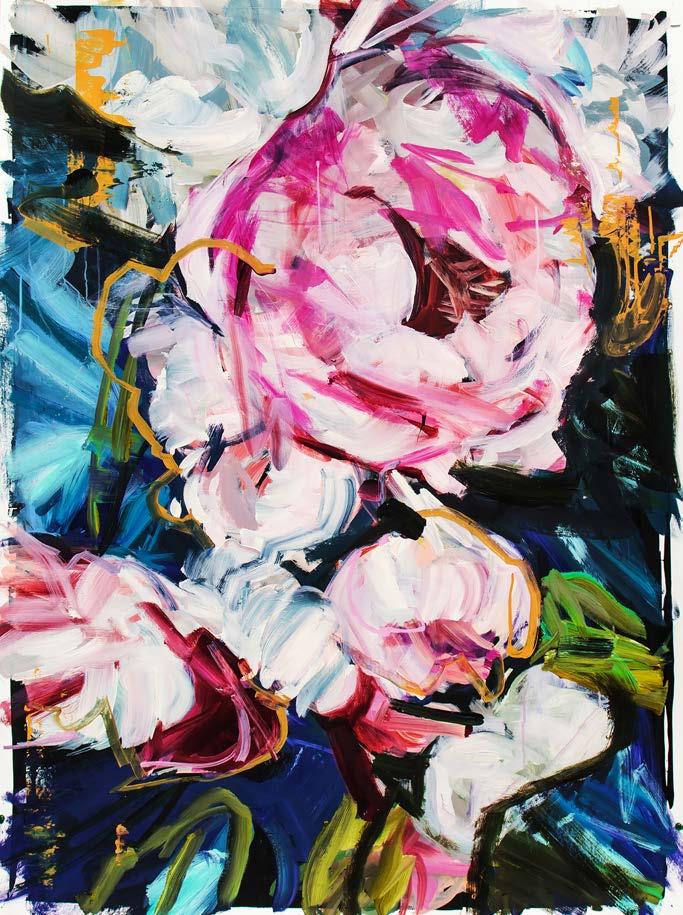 Carmelo Blandino, Study for a Painting I, 2018, Acrylic on paper, 52 x 40 in. On loan from the private collection of Barbara Burris.
Carmelo Blandino, Study for a Painting I, 2018, Acrylic on paper, 52 x 40 in. On loan from the private collection of Barbara Burris.
Ratio, the Fibonacci Rule, well it’s all integrated in there. That’s the part that I definitely come in with with the structure in my composition so that people have a platform that they can stand on that doesn’t exactly lean one way or lean the other way. It’s a horizontal platform. They feel safe. They can look at the paintings through that. They recognize that there’s something keeping them there, although they may not understand that it’s the actual composition and structure. But then I come in with the abstract part, and so what happens is you’re feeling safe and you open yourself up because the structure is inviting you in, and then slowly start to see the mystic in the painting. And the mystic is the abstraction, so that opens up the heart. So it’s, it’s kind of like a twofold. It’s gate one, gate two, gate three, you know, you can kind of get through it. So it’s all done and calculated in a subliminal way. But I guess I do it in the same way that I was introduced to it. Sometimes being hit too hard with this could be a turn off. I also want people to appreciate the work. I mean, I always say what is an artist without its audience, you know? You’re doing this for the people, and the people in turn, are encouraging you to continue doing it. It’s such a beautiful relationship. It’s just, it’s a cycle. It’s a beautiful cycle.
JL: You are talking about the structure of a religious experience through composition and architecture and how that is embedded in your work, but it’s not overt and it’s not limited to anyone’s belief system. Maybe on a subconscious level we feel that those structures seem otherworldly or mystical, but we may not know why. It’s because of your training and your appreciation of these experiences you’ve had, that they’re embedded in your paintings.
CB: We call it embedded coding. They’re all coded, every single one has a code. Every single one has a sense of what I call harmonic. The colors tend to end up having harmonics, and they open up to the influence of what we call the Mystic. I’ve studied Hinduism, Buddhism, the chakras, and read the Koran. And you start to realize that we have, there’s a life force within us, you know, and that life force it connects certain emotions. Each one of these emotions actually has a color associated to it, and those colors are the same colors I repeat all the time, which is like 8 notes on a keyboard. The eight colors that we use all the time, and we keep mixing them all the time to generate some sort of emotional response. I work with those structures. That’s the part of the mystic that I think I’m savvy enough to understand. But to say savvy means that I’m intellectually putting it together, which I’m not… I don’t want to jump too far ahead with the question but I have to say that all the times I don’t know what I’m doing when I’m painting, you know I really just get out of the way and allow it to happen. And there’s many moments where I’ll just be mesmerized by it. This usually takes place in the last phase of the painting. I usually begin with an idea of what I want to do and then create a structure and form based on sort of like the composition or ideas of relationship. And then I open what I call the portal and then I just let it go. And in the last phase I’m just mesmerized. So many times I’m closing the lights in
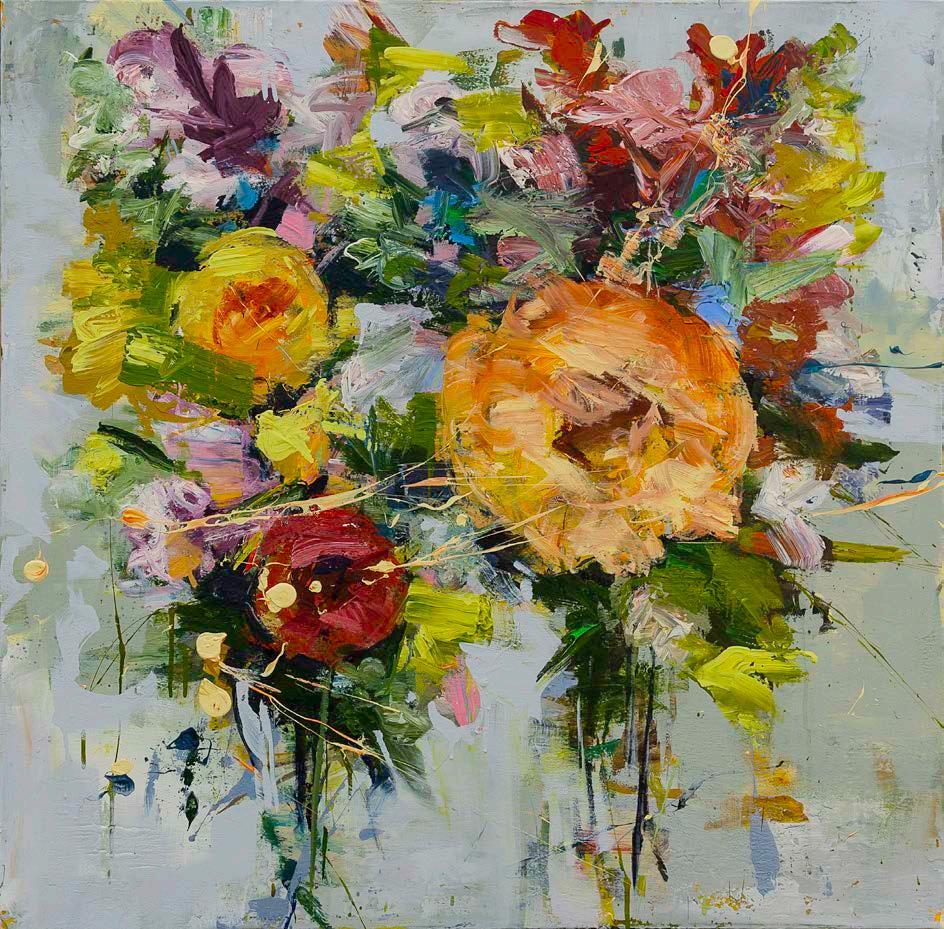 Carmelo Blandino, Operetta II, 2014, Acrylic on canvas, 36 x 36 in. On loan from the private collection of Amy and Chad Jensen.
Carmelo Blandino, Operetta II, 2014, Acrylic on canvas, 36 x 36 in. On loan from the private collection of Amy and Chad Jensen.
the studio and I’m leaving and I have to stop in front of this painting and say, like, shit when was this done? Like, how did this get here? And for me, it’s a very emotional experience. There have been many times where I’ve just cried in front of my painting because it’s like something that, for me, is not of this existence. I don’t know who’s gonna buy it. I don’t know where it’s gonna go. But it needed to be done. And so that’s it, that’s the eternal pursuit that I have. It’s like I’ve become sort of like a tool for some form of communication to use me and say let’s work on something today.
JL: More recently you’ve been introducing another subject matter into your work that has a basis in pop culture. You have been introducing superheroes and comic book characters into your paintings. Where is that coming from?
CB: That is so awesome. I always sort of wondered why do we even have these superhero icons? Then of course you start to realize that they’re archetypes that we all carry, like the hero, the rescuer, the villain, these are all archetypes that we carry as personalities.
JL: Going back to Greek philosophy and storytelling?
CB: Right! Let’s go back to the Greek gods and philosophy. There was a point in our history where legend has it that they actually existed and each one represented a certain part of our split personality. They are fragments of us. Now we’ve embellished them, we’ve just given them colorful costumes and they’re larger than life once again. Here we go again with the larger-than-life idea and I think for me they’ve always been an outlet of playfulness. They are an exploration in terms of archetypes, and I’ve recognized myself in them many times, but as I’m getting older, I’m realizing that why not play with these characters? They’re just such a part of our background, we don’t even realize it. Like they’re always there. You go to a shopping center, you’re going to find that superhero doll or t-shirt, they’ve just become so integrated into our lifestyle. I looked at them and said, why would I deny that part of my artistry also, and why not start bringing them in in some form or some method without being so cheeky about it or without being so obvious about it.
I remember my brother gave me one of my very first comic books. It was a Superman comic, which I think I bought like 6 copies of it now, just because of that souvenir that’s associated to it. The feeling that I got from that comic was probably the same feeling I got from looking at one of the old master paintings. There was no difference between the two. I know people can argue and say, “Well how can you equate the work in there to one of the masters?” It’s not about the work, it’s about the the feeling that it actually gives you, that sense of inspiration. I look at that and I’m like wow that there’s something
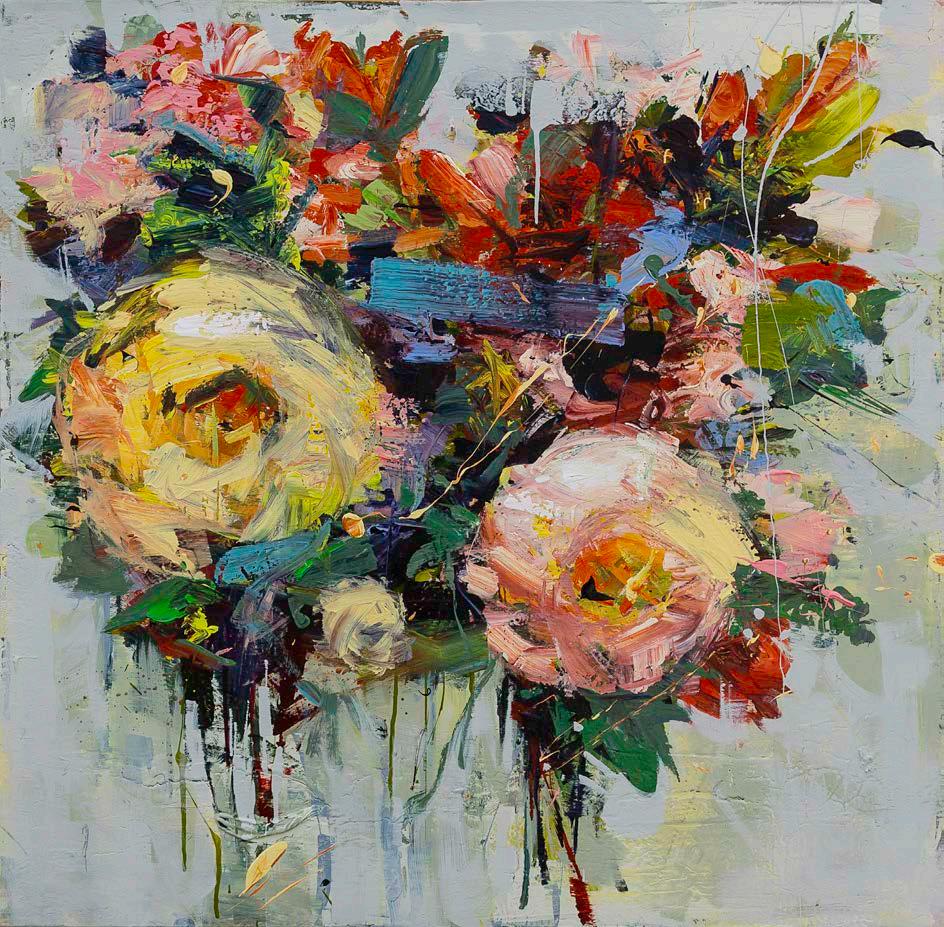 Carmelo Blandino, Operetta III, 2014, Acrylic on canvas, 36 x 36 in. On loan from the private collection of Amy and Chad Jensen.
Carmelo Blandino, Operetta III, 2014, Acrylic on canvas, 36 x 36 in. On loan from the private collection of Amy and Chad Jensen.

 Carmelo Blandino, Study for a Painting IX, 2018, Acrylic on paper, 52 x 40 in. On loan from the private collection of Charlotte Corddry.
Carmelo Blandino, Study for a Painting V, 2018, Acrylic on paper, 52 x 40 in. On loan from the private collection of Charlotte Corddry.
Carmelo Blandino, Study for a Painting IX, 2018, Acrylic on paper, 52 x 40 in. On loan from the private collection of Charlotte Corddry.
Carmelo Blandino, Study for a Painting V, 2018, Acrylic on paper, 52 x 40 in. On loan from the private collection of Charlotte Corddry.
here, so I started to integrate it into my work. Where you see it is in the screen printing and the elements of line and color. Sometimes you’ll see superhero characters in the background in some of my new work. We’ll see where it’s all gonna go. It’s playful and I think the older you get, you start to realize that there’s a lot of things you can play with. There’s a lot of things you can permit yourself to do. You know, you’ve done a lot of stuff that sort of falls into a category of structure of, you know, if you want to be recognized as an artist, you need to qualify at this level. Then you need to qualify at this level. And you just get to a point. You’re just sort of like, why do I need to do any of that? If I want to bring in superheroes and somebody has something to say about it, good. Let them have fun. That’s none of my business. My business is painting the best painting I could do with the best expression that I could do.
JL: I know, the subject matter is fairly new for you in the way that it’s appearing in your paintings now and you may not necessarily want or need to reconcile the meaning. I think that’s the whole point that you were talking about before, being in a state of mind where you start with the structure but then you allow a more subconscious or other force to come through. It seems as though maybe the introduction of these pop culture icons or these archetypes, is another way for you to push your own boundaries, and I’m not necessarily looking for an answer, but I’m curious if you’re finding yourself surprised at what that has done for your work?
CB: Yeah, yeah, it has actually. It’s kind of catapulted my work into this whole form of expression of…In French it’s called “L’aisée Être”; “Just let it be”. Just let it be what it needs to be. If you have this desire to express this just then just put it down, right? What ends up happening is you end up carrying that with you outside of the studio. If you have something to say, just say it. You know you have something to do, just do it. Let other people concern themselves or whatever. They’re triggered based on your actions, right? In a certain responsibility with that I get it, but at some point you end up pushing those boundaries. There’s more to this expression. Like I can’t put my finger on it right now. I think I’m glad that I can’t put my finger on it because then it would end the entire process.
JL: Circling back, you mentioned the peony as one flower that you use. Are there flowers that you are choosing for some purpose? Is there a reason why you’re choosing certain types of flowers?
CB: Yeah, the softness, mostly. I like the shape, and the shape is great for composition. That helps direct the eye across, I think, the softness of the flowers. There’s also, like there’s a sense of grace. A lot of the flowers I choose have grace in them. They have integrity. That’s what I look for. Beauty, definitely. I’m always chasing beauty. Those are the things I look for. I remember doing a painting called Glorious Laughter, and these flowers were all just talking to each other and laughing and kind of like in
 Carmelo Blandino, Divine Gift, 2020, Acrylic on canvas, 42 x 72 in. On loan from the private collection of Candace
Carmelo Blandino, Divine Gift, 2020, Acrylic on canvas, 42 x 72 in. On loan from the private collection of Candace
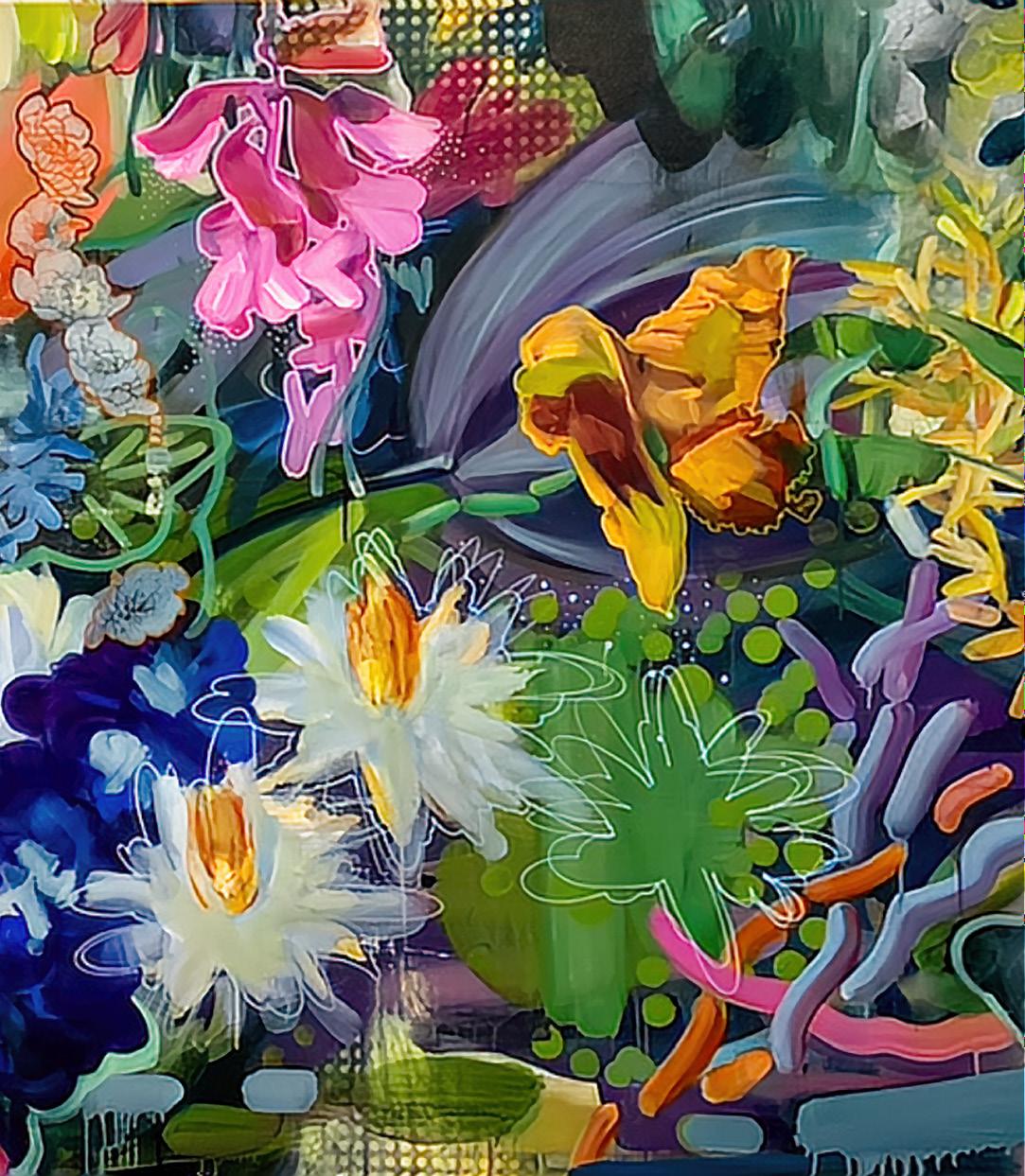 Candace and William Raveis.
Candace and William Raveis.
the room, and they were all pointing to one another, and it was this big, smorgasbord of stuff. I loved that painting because it had all those qualities. It had the grace, the integrity, and the playfulness. And that’s how I choose the flowers. Bringing it back to people and their personalities; when you enter a room, you’re in a cocktail party, or you’re always a little apprehensive of, like, who am I going to meet here? So you tend to gravitate probably to the one that’s more graceful or the one that tends to be nicer, more approachable. And so those are all qualities I like to have in my paintings.
JL: I like that you brought in this idea that the flowers can stand in for people, for the relationships between people, and the moods and the emotions that they have in that moment. I think that’s different than what we were talking about earlier with the structure disintegrating. But to be able to keep both those things in your mind at the same time hints at what you’re doing as an artist. You are seeing the work with multiple perspectives and ideas at the same time. How do you allow all those to coexist, the mystical, the playful, the childlike, without any one of them kind of overwhelming the other? Is that the balance you are talking about?
CB: That’s exactly it. It’s keeping that balance between us. If we do it as people getting back to nature, we are nature, flowers are nature. We keep a balance between each other as people. If we don’t keep the balance, we lose our peace, lose our sense of peace, compassion, joy. We fall into these dark areas of psychology also, as much as we put a lot of attention to the physical part, I think at an early age, if we would all focus on psychology before we go, we’d probably be a lot better off just that part of it, too. It becomes important to me to be able to put these pieces out there and show the relationship between how one relates to the other.
The other day one of my patrons came up to me and said he was completely moved by the paintings, and as he was looking at them, he realized that I’m not painting as an artist because you’re painting from a different realm. And I looked at him and I said, “Okay, well, tell me,” because I figured that he tapped into something. And he says, “Artists are here and you’re in this realm over here.” And he said, “It’s all embedded with light, and it’s embedded with wellbeing, with healing qualities, and it’s embedded with a sense of balance.” So he says it’s coming from another realm.
JL: Well, I think he’s picking up maybe on your intent. If you’re coming to the studio practice with the intent of entering a meditative practice or allowing yourself to explore ideas that you don’t know the answer to, and you’re able to preserve that in the work, then I think, yes, other people are going to start to see that intent come through.
CB: The intent. I think it’s one of the first times I actually had somebody come in and start reading the Ethereal, really reading the mystic, and we’re talking about most recent pieces. For me, that was like a
guide post saying, now we’re entering a different relationship with your fingers. So it’s exciting for me to hear that because you put a lot of time in the beginning trying to perfect your craft, right? You want to be recognized as having proper skills and kind of like you’re a basketball player and you’re always like, I gotta get that shot, I got to do this, I got to do it right?
Then, at some point, you forget about all of that. You just pick up your brush and go to the studio and you’re not even thinking about the muscle memory response. You’re in that realm now. You’re in the realm of creativity. And sometimes it takes no time at all to just be able to create a painting. Maybe that was the message coming to me from the ether, saying, this is where you’re at now, through this person. And for me, it was just a marker. I don’t know how to explain it, John, but it was definitely something definitive happened at that moment. And I went, okay, I’ve just been given a sort of message. Let me sit with this for a while. The work is doing what it’s meant to do. That left me in a good spot, like understanding if anything were to happen to me, I’m leaving happy. It’s where we strive for Azaris to get that language and that communication going, the narrative, the vocabulary in proper sync with the hearts of the people that are looking at it. And when I would get a response like that from somebody, I’m like, this is it. Now I’m starting to really touch on the infinite. This makes sense.
 Carmelo Blandino, CRASH, 2022, Mixed media on canvas, digital overlay, 52 x 72 in. Courtesy of the artist.
Carmelo Blandino, CRASH, 2022, Mixed media on canvas, digital overlay, 52 x 72 in. Courtesy of the artist.
CARMEN BLANDINO - BIOGRAPHY
Since 2005, the paintings of Carmelo Blandino have derived a wealth of visual splendour and emotional resonance from flowers, assembling them into wondrous, intuitive compositions, quiet riots of comforting colours and delicate dynamics. He has rigorously refined an approach one might call “urban baroque”, combining the subtleties of classical oil painting with the crackling energy of contemporary spray-paint-and–stencils street styles.
With his latest collection of paintings Blandino reaches beyond his familiar assemblages of blossoms and discovers entire new worlds to contemplate in the solitary flower. A reflection of Blandino’s practice of meditation, the “flowering” to which the exhibition’s title refers isn’t simply the blooming of a new blossom but a more universal notion, that of the act of becoming, of moving from a state of obliviousness to one of awareness.
Paradoxically collecting the potency of their individual personalities together, these new flowers of Blandino’s possess the space of not just their canvases but the gallery itself, transforming it into a garden of delights, an array of independent universes to be admired and explored on their own and as one.
Born to Sicilian parents in Tübingen, Germany, and raised in the culturally charged city of Montreal, Quebec, Blandino studied art and design at the city’s local colleges and began a successful career as a freelance illustrator, working with architects, designers, and advertising agencies. In 2002, Blandino shifted his focus to the world of fine art. Today, his paintings are widely known for their immediacy and their sensual, even lascivious expressions of colour, movement, and shape. His work is exhibited in New York, Palm Beach, Naples, Stockholm, Calgary, Vancouver, Toronto and his beloved Montreal. He has conducted summer workshops at Von Liebig Art Center of Naples, Florida, and taught drawing for many years at Dawson College on the interrelations between nature, beauty, and the origins of humanity. This new exhibition displays the range and variety of the artist’s palette; vibrant colours, charged movement, and the recognition of beauty as the most significant marker in the evolution of human consciousness. Carmelo Blandino’s flowers are up with joy, laughter, and drunkenness of spirit, cheerfully reflecting the ragged meadow of the soul.
REPRESENTATION
Canada: Galerie De Bellefeuille, Montréal Quebec
United States:
Peabody’s Interiors / Milwaukee Wisconsin
Sono Gallery / Norwalk Connecticut
Greenwich Gallery / Greenwich Connecticut
Jane Eckert Fine Art / Millerton New York
Cliff Young / New York New York
Monika Olkos Gallery / Sag Harbour/ New York Method & Concept / Naples Florida
Tew Gallery / Atlanta Georgia
Europe :
Couture Gallery / Stockholm Sweden
JPB Art Gallery/ St.Tropez France
Rarity Gallery / Mykonos Greece Asia: Lans Gallery/ Hong Kong China
EDUCATION
1983-1984
Workshops
2000-2001
TEACHING EXPERIENCE
1992- 1994 St Lawrence College, Fine Arts Department,Ontario
Vanier College: Creative Arts
1985-1988 Dawson College: Illustration and Design
Saidie Bronfman Center: Drawing and painting
1991-2006 Dawson College Montréal, Québec Professor of drawing, painting in the Illustration and Design Program
2007-2009 The Von Liebig Art Center, Naples Fl
2013 The Von Liebig Art Center, Naples Fl
2014 Creativity is Natural / Lecture series/ Naples art Association
2014 Portrait I Painting/ Portrait II painting Workshops / Naples Art Association
2015 Intensive Drawing Workshop/ Bonita Arts League
2015-2017 Intensive Drawing and painting Workshops / Bonita Arts League
BIBLIOGRAPHY
2020 American Art Magazine / January/ Artist Focus on Carmelo Blandino
2019 American Art Magazine / December/ Carmelo Blandino page 170
2016 IN BLOOM The Art Of Carmelo Blandino 176 pages, coffee table book
2016 North Point Magazine / Milwaukee
2016 M Magazine
2015 Huffington Post / Kindred Spirits:Carmelo Blandino Hunt Slonem
2015 Studio Visit Magazine
2015 World of Interiors / What’s Trending
2015 House and Garden / What’s Trending
2014 American Art Collector / March Floral issue
2013 Maps Magazine. Front Cover display of A Love Song
2013 Gulfshore Life 01/01/2013
2010 Naples Illustrated / Legends of the Fall / Oscar De La Renta / Carmelo Blandino
Gulfshore Life ( Rising Stars ) 01/15/2010
Gulfshore Life / the art of style 09/08/2010
Carmelo Blandino: Pulse Magazine 9 artist profile) 01-15-2010
2009 Naples Florida Weekly / Third on Canvas event culminates in live auction. Among the participating artists are: Paul Arsenault, Carmelo Blandino
Transitions: Building Bridges to Your Points. Presentation. Speakers include painter Carmelo Blandino, floral designer Anne Dancu of Blue Pear, makeup artist Sharon ...
Chart Presentation: Signals - Inside Futures
2008 MASS ART GUIDE -AUDIO CARMELO BLANDINO. Hosted by: Julie Glick Recorded: July 2008. Length: 26 1/2 Minutes. Upcoming exhibitions: Toronto International Art Fair October 3-6, www.massartguide.com/audio/200809_carmelo_blandino_toront.php
NAPLES DAILY NEWS / At home with Art. 13th Annual Artists’ Studio Tour opens door to creative work and living spaces By JANICE T. PAINE Wednesday, February 27, 2008
CTV.ca / Holiday Guide Top 10 luxury gifts to covet this holiday season/ #8 A gift of Art at the Art Gallery of Ontario’s Art Rental & Sales Gallery you can purchase from approximately 700 pieces of original art by Canadian contemporary artists such as Denyse Thomasos, Cathy Daley, Carmelo Blandino and Derek Sullivan...
Fri. Dec. 19 2008 9:43 AM ET Sheri Block, CTV.ca. Marco News / 2008 Faculty Biennial on view at von Liebig By ETC staff
Sunday, August 24, 2008 Fort Myers Florida Weekly: Naples Museum of Art holds studio tour
SPECIAL TO FLORIDA WEEKLY...Carmelo Blandino takes the most time-honored subjects of painting - landscapes, florals and the human figure - and makes them seem fresh and daring. His encaustic paintings are often large-scale and meditative, conveying the rich mysteries of nature.
RBC Canadian Painting Competition / Ten years / Publication / 2008 Royal Bank of Canada
Edited by Laurel Mac Millan
Shining Through: The Art of Carmelo Blandino. Text by Betty Ann Jordan.
“Bless the spirit that makes connections” 2006 Canadian House & Home / Tea Time, page 72
2005 Toronto Star, Deft Mix of Light & Dark. Corriere Italiano, May 6th , L’Encan per Santa Cabrini, un appuntamento divertente da non mancare!
2002- Grafika Magazine, numero 68, mars 2001, Carmelo Blandino illustrateur, Le Talent Partagé 2001
WORK EXPERIENCE
2006-Present Artist/Painter Canada/USA/Europe
1991-2006 Vice-president / Nine High Inc., Montréal
1991-2006 Professor / Dawson College Montréal Illustration & Design Program
1992-2004 Principal at Studio 100 Dessins ( illustration studio)
1992-1998 Professor St-Lawrence College / Ontario
1991-1992 Assistant illustrator / Suzanne Duranceau Inc., Montréal
1989-1991 Illustrator / Studio de la Montagne, Montréal
1986-1989 Anchor advertising, Montréal
MUSEUM COLLECTIONS EXHIBITIONS
2020 Wausa Museum Wisconsin USA: ETHOS: Solo exhibition
2019 Brenau Museum Georgia USA: ETHOS: Solo exhibition
2017 Wausa Museum Wisconsin USA Group Exhibition
2017 Baker Art Museum, Naples Florida, Florida Contemporary
2016 Brenau Museum Georgia USA: Lasting Impressions I 60x60/ Lasting Impressions II 60x60 Fio-ri Crescendo I 36x36 permanent collection.
2016 Baker Art Museum, Naples Florida, Florida Contemporary
2015 Brenau Museum Georgia USA: Cantabile 60x60/ Mi Riccordo 60x60/ The Unfolding 60x60 permanent collection.
2014 Baker Art Museum, Naples Florida, Florida Contemporary
2002 Montreal Museum of Fine Arts / Contemporary Gallery permanent collection
EXHIBITIONS
2023 Florida Gulf Coast University Retrospective Exhibition/ Estero, Florida
2022 Children’s Museum of Contemporary Art: Selection of works/ Naples, Florida
2020 Naples Botanical Gardens: Convergence: Solo exhibition/ Co-Curated by Method & Concept, Naples, Florida
2020 WMOCA Wasau Museum of Contemporary Art USA: Ethos: Solo exhibition
2020 Method & Concept Gallery Group Exhibition / Naples Florida, USA
2019 Brenau Museum Georgia USA: Ethos: Solo exhibition
2018 Solo Exhibition / Artist in Residence / Method & Concept, Naples, Florida
2017 Group Exhibition / Rarity Gallery / Mykonos Greece
2017 Solo Exhibition / Galerie De Bellefeuille / Montreal Quebec
2016 Group Exhibition / Lans Gallery/ Hong Kong Solo Exhibition / Peabody’s Interiors
2015 Solo Exhibition / Galerie De Bellefeuille Montreal Quebec
Carmelo Blandino Hunt Slonem Kindred Spirits / Carmel Indiana
Solo Exhibit/ The Art of the Garden/ Jane Eckert Fine Art and Consulting
Solo Exhibit/ Candy Flowers / Method & Concept / Naples Florida Spring Group Show / Method & Concept Coats Wright Fine Arts / Collaboration with Hunt Slonem/ Carmel Indiana
Solo Exhibit/ Galerie de Bellefeuille/ Montreal
2014 Wolf Kahn / Carmelo Blandino / Galerie Sono / Connecticut
Solo Exhibit / New Works/ One person show/ Glarie Sono/Connecticut
Solo Exhibition / New Beginnings /Couture Galleri, Stockholm Sweden Baker Museum / Florida Contemporary / Naples Florida Lecture and Exhibition “Creativity is Natural” / Von Leibig / Naples Art Association Solo Exhibit & Lecture / Suspended Dialogues / Method & Concept, Naples, Florida
2013 Solo Exhibition / Rebirth, Sono Gallery Norwalk Connecticut
Art Basel Miami/ Wynwood Walls Gallery Sono/ Connecticut JLD Design Showroom / Café Des Artistes Hall-Barnett Gallery/ New Orleans
2012 Miami art Basel/ Wynwood walls
Solo show/The flowering of consciousness / Galerie de Bellefeuille Montreal Group Show/ Arcadia Fine Arts / Four Seasons hotel New York City En Masse group show, / Galerie Pangee
2011 En MAsse/ Primary flight/ Wynwood walls/ Art Basel Miami Fountain Art Fair, / Miami Art Basel Toronto International Art Fair / TIAF
2010 Solo show/The Earth Laughs In Flowers/ Couture Gallery / Stockholm Solo show/The Earth Laughs In Flowers/ Galerie De Bellefeuille/ Montreal 29th Founders Show / Von Leibeig art center / Naples Florida Art 2010, Group show Galerie De Bellefeuille
2009 Art 2009, Group show Galerie De Bellefeuille Breathe, Group show, , Judith Liegeois showroom Nature 2009, Group show, Galerie De Bellefeuille Wallace Gallery, Fall Show Third on Canvas, The Von Liebig Center, Naples Naples Museum of Art, Have a Seat II
2008 Art 2008, Group show Galerie De Bellefeuille
Art show, Judith Liegeois showroom
Naples Museum Studio Tour
Palm Beach Art Fair
Solo show / Memoria, Galerie De Bellefeuille
Faculty Biennial, Von Liebig Art Center
Solo show, Sanctus- Bau-Xi Gallery, Vancouver Chicago Art Fair
Toronto Art Fair ( TIAF)
2007 Group show, Art 2007, Galerie De Bellefeuille
Toronto International Art Fair
Palm Beach Art Fair, Galerie De Bellefeuille
Solo show,Vivo- Bau-Xi Gallery, Toronto Small works- Bau-Xi Gallery, Vancouver
Solo show- Bau-Xi Gallery, Vancouver
Solo show- Galerie De Bellefeuile, Montréal
2006 Small works- Bau-Xi Gallery, Vancouver
Solo show- Bau-Xi Gallery, Vancouver Solo show- Galerie De Bellefeuile, Montréal
2005 Figura - Galerie De Bellefeuille Group Show Galerie De Bellefeuille Group II Show Galerie De Bellefeuille
Solo show at Galerie de Bellefeuille - Landscapes and Florals
Art Chicago - Chaicago Art Fair
Art For Life - Casey House Foundation
Toronto International Art Fair
2004 The Painted Gift - Hubert Gallery in New York
Small Works - Bau-Xi Gallery in Toronto and Vancouver
Art For Life - Casey House Foundation
Art Gallery of Ontario, Toronto
Galerie De Bellefeuille, Montréal
Circa 700 - Bau-Xi Gallery Toronto
2003 Pausa - Bau-IX Gallery in Toronto
Galerie De Bellefeuille. Montréal
2002 Galerie Simon Blais, Montréal
Bau-IX Gallery in Toronto, Ontario, Canada
Musée des Beaux-Arts de Montréal, Montréal
New Canadian Painting Royal Bank of Canada, Place Ville-Marie, Montréal
New Canadian Painting Competition, Royal Bank of Canada Exhibit, Ottawa Viva Italia, Holt Renfrew, Montréal
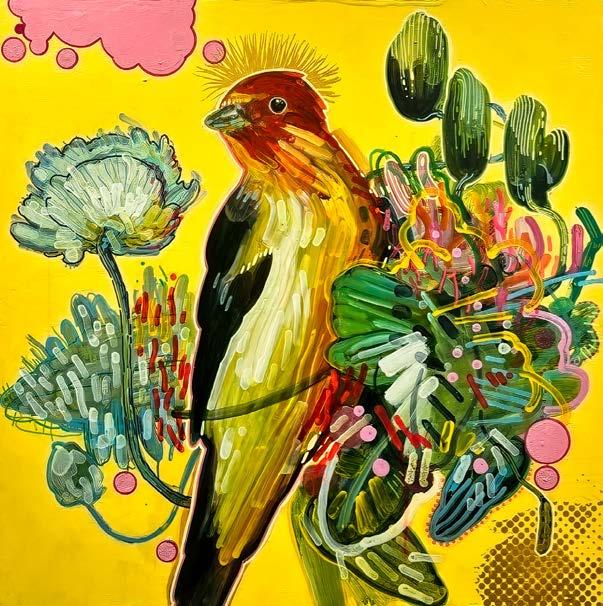 Carmelo Blandino, Yellow Bird 1, 2022, Acrylic on canvas, 40 x 40 in. Courtesy of the artist.
Carmelo Blandino, Yellow Bird 1, 2022, Acrylic on canvas, 40 x 40 in. Courtesy of the artist.
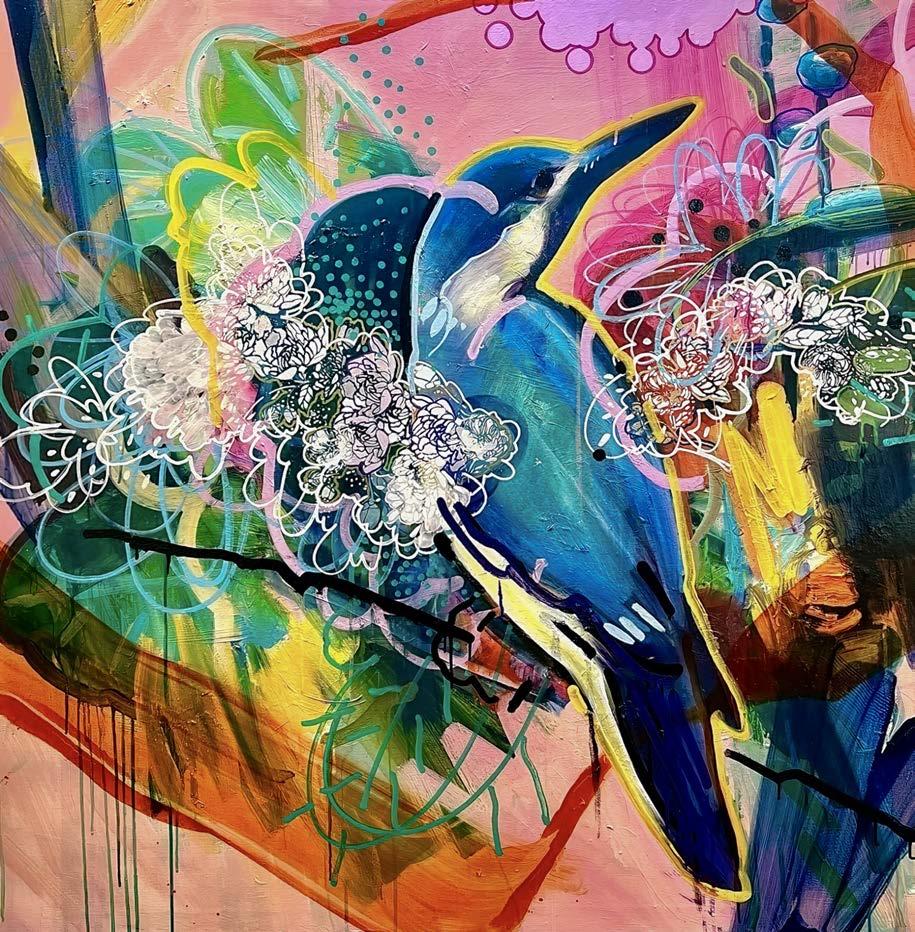 Carmelo Blandino, Bluebird 1, 2022, Acrylic on canvas, 48 x 48 in. Courtesy of the artist.
Carmelo Blandino, Bluebird 1, 2022, Acrylic on canvas, 48 x 48 in. Courtesy of the artist.
Director
Loscuito Assistant Curator/Graphic Designer Anica Sturdivant Lead Gallery Assistants Breah Fyffe Gallery Assistants Sara Baker Amanda Claro Ash Cohen Payton Kern Emily Leeper Copy Editor Joanna Hoch Photos Copyrighted and Courtesy of Carmelo Blandino unless otherwise stated
John
fgcu.edu/artgalleries
FGCU Art Galleries 10501 FGCU Boulevard South Fort Myers, FL 33965-6565 (239) 590-7199 | artgalleries@fgcu.edu
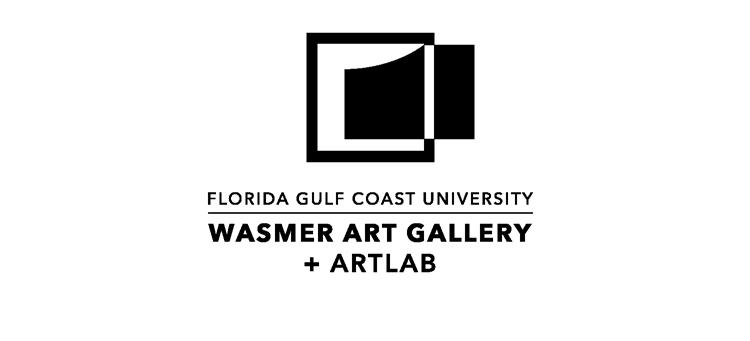
Art Gallery Hours M-F 10am to 4pm
Back cover: Carmelo Blandino, CRASH (detail), 2022, Mixed media on canvas, digital overlay, 52 x 72 in. Courtesy of the Artist.






 Carmelo Blandino seated before his painting, Baraka, 2020, Acrylic and spray paint on canvas, 96 x 72 in. On loan from the private collection of Louise Penta.
Carmelo Blandino seated before his painting, Baraka, 2020, Acrylic and spray paint on canvas, 96 x 72 in. On loan from the private collection of Louise Penta.
 Carmelo Blandino, Ethos, 2019, Acrylic on canvas, 96 x 96 in. Collection of FGCU Art Galleries, Gift of Martin and Melanie Wasmer.
Carmelo Blandino, Ethos, 2019, Acrylic on canvas, 96 x 96 in. Collection of FGCU Art Galleries, Gift of Martin and Melanie Wasmer.
 Carmelo Blandino in studio working on Ethos, 2019, Acrylic on canvas, 96 x 96 in. Collection of FGCU Art Galleries, Gift of Martin and Melanie Wasmer.
Carmelo Blandino in studio working on Ethos, 2019, Acrylic on canvas, 96 x 96 in. Collection of FGCU Art Galleries, Gift of Martin and Melanie Wasmer.
 Carmelo Blandino, Garden of Delights, 2019, Acrylic and charcoal on canvas, 60 x 144 in. On loan from the private collection of anonymous lender.
Carmelo Blandino, Garden of Delights, 2019, Acrylic and charcoal on canvas, 60 x 144 in. On loan from the private collection of anonymous lender.
 Carmelo Blandino, No Thing Bouquet, 2019, Acrylic and pastel on canvas, 60 x 60 in. On loan from the private collection of Rick and Katrina Kash.
Carmelo Blandino, No Thing Bouquet, 2019, Acrylic and pastel on canvas, 60 x 60 in. On loan from the private collection of Rick and Katrina Kash.
 Carmelo Blandino, Study for a Painting VII, 2018, Acrylic on paper, 52 x 40 in. On loan from the private collection of Charlotte Corddry.
Carmelo Blandino, Study for a Painting VII, 2018, Acrylic on paper, 52 x 40 in. On loan from the private collection of Charlotte Corddry.
 Carmelo Blandino, Study for a Painting I, 2018, Acrylic on paper, 52 x 40 in. On loan from the private collection of Barbara Burris.
Carmelo Blandino, Study for a Painting I, 2018, Acrylic on paper, 52 x 40 in. On loan from the private collection of Barbara Burris.
 Carmelo Blandino, Operetta II, 2014, Acrylic on canvas, 36 x 36 in. On loan from the private collection of Amy and Chad Jensen.
Carmelo Blandino, Operetta II, 2014, Acrylic on canvas, 36 x 36 in. On loan from the private collection of Amy and Chad Jensen.
 Carmelo Blandino, Operetta III, 2014, Acrylic on canvas, 36 x 36 in. On loan from the private collection of Amy and Chad Jensen.
Carmelo Blandino, Operetta III, 2014, Acrylic on canvas, 36 x 36 in. On loan from the private collection of Amy and Chad Jensen.

 Carmelo Blandino, Study for a Painting IX, 2018, Acrylic on paper, 52 x 40 in. On loan from the private collection of Charlotte Corddry.
Carmelo Blandino, Study for a Painting V, 2018, Acrylic on paper, 52 x 40 in. On loan from the private collection of Charlotte Corddry.
Carmelo Blandino, Study for a Painting IX, 2018, Acrylic on paper, 52 x 40 in. On loan from the private collection of Charlotte Corddry.
Carmelo Blandino, Study for a Painting V, 2018, Acrylic on paper, 52 x 40 in. On loan from the private collection of Charlotte Corddry.
 Carmelo Blandino, Divine Gift, 2020, Acrylic on canvas, 42 x 72 in. On loan from the private collection of Candace
Carmelo Blandino, Divine Gift, 2020, Acrylic on canvas, 42 x 72 in. On loan from the private collection of Candace
 Candace and William Raveis.
Candace and William Raveis.
 Carmelo Blandino, CRASH, 2022, Mixed media on canvas, digital overlay, 52 x 72 in. Courtesy of the artist.
Carmelo Blandino, CRASH, 2022, Mixed media on canvas, digital overlay, 52 x 72 in. Courtesy of the artist.

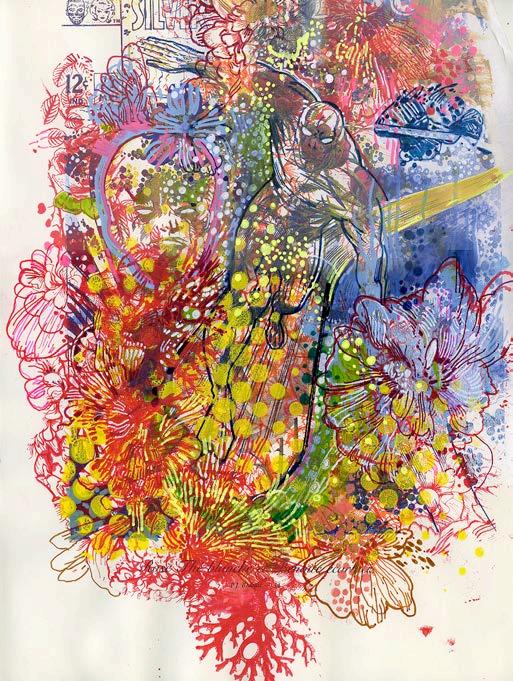



 Blandino, Final 5, 2022, Acrylic on paper, 10 x 13 in. Courtesy of the artist.
Blandino, Final 6, 2022, Acrylic on paper, 10 x 13 in. Courtesy of the artist.
Blandino, Final 5, 2022, Acrylic on paper, 10 x 13 in. Courtesy of the artist.
Blandino, Final 6, 2022, Acrylic on paper, 10 x 13 in. Courtesy of the artist.



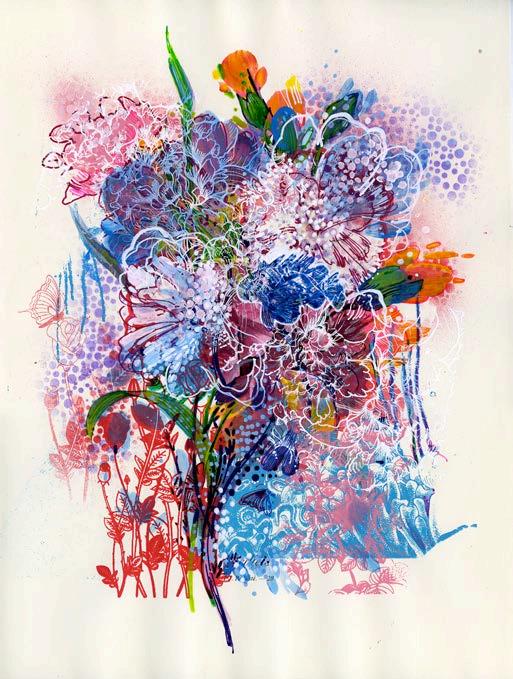


 Carmelo Blandino, Yellow Bird 1, 2022, Acrylic on canvas, 40 x 40 in. Courtesy of the artist.
Carmelo Blandino, Yellow Bird 1, 2022, Acrylic on canvas, 40 x 40 in. Courtesy of the artist.
 Carmelo Blandino, Bluebird 1, 2022, Acrylic on canvas, 48 x 48 in. Courtesy of the artist.
Carmelo Blandino, Bluebird 1, 2022, Acrylic on canvas, 48 x 48 in. Courtesy of the artist.

